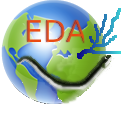Changes between Version 13 and Version 14 of Eda Description
- Timestamp:
- Mar 11, 2010 1:54:52 PM (15 years ago)
Legend:
- Unmodified
- Added
- Removed
- Modified
-
Eda Description
v13 v14 13 13 The presence/absence and densities of yellow eel in France are obtained from the Aquatic environment and fish database (BDMAP - more than 11 787 fishing samples used, collected on 6 007 sampling stations) from the French National Office of Water and the Aquatic Environments (ONEMA) and other databases from the Brittany watershed. 14 14 15 Values of the explanatory variables are calculated for each segment of the river network. The distance to the sea , the relative distance (between sea limit and the more upstream source) are directly calculated from the river network topology. The temperatures are extracted from the CRU (Mitchell et al., 2004) and Worlclim (www.worldclim.org/). Elevation and slope are extracted from the National Height Elevation Database (BD ALTI® - spatial resolution of 50m) from the National Geographic Institute. The obstacle pressure (characteristics, Steinbach rank…) comes from the National list of obstacles to river flows (ROE) from the ONEMA. Glass eel fisheries data set comes from Castelnaud (1994), non-professional/leisure fisheries and professional fisheries data set from the ONEMA.15 Values of the explanatory variables are calculated for each segment of the river network. The distance to the sea and the relative distance (between sea limit and the more upstream source) are directly calculated from the river network topology. The temperatures are extracted from the CRU (Mitchell et al., 2004) and Worlclim (www.worldclim.org). Elevation and slope are extracted from the National Height Elevation Database (BD ALTI® - spatial resolution of 50m) from the National Geographic Institute. The obstacle pressure (characteristics, Steinbach's expertise score…) comes from the National list of obstacles to river flows (ROE) from the ONEMA. Glass eel fisheries data set comes from Castelnaud (1994), non-professional/leisure fisheries and professional fisheries data set from the ONEMA. 16 16 The data sets used to extract the water quality parameters are obtained from the RNABE database (/ROM database of ONEMA?). 17 17 18 The statistical model is calibrated with a Generalized Additive Model (Hastie and Tibshirani, 1990), using the ‘gam’ library in the R software. This semi-parametric extension of generalised linear models is flexible and allows combination of both linear and complex additive responses within the same model. The best model is selected by the Akaike’s Information Criterion (AIC) ,and Kappa coefficient when presence-absence models were used.18 The statistical model is calibrated with a Generalized Additive Model (Hastie and Tibshirani, 1990), using the ‘gam’ library in the R software. This semi-parametric extension of generalised linear models is flexible and allows combination of both linear and complex additive responses within the same model. The best model is selected by the Akaike’s Information Criterion (AIC) and Kappa coefficient when presence-absence models were used. 19 19 20 20 For technical reasons, silver eel densities are unachievable and exhaustive samplings are rare, so an indirect method is used to estimate the silver eel stock from the knowledge of the yellow eel stock. The silver eel stock is obtained with a conversion rate which will be calibrated according to known silver eel productions. 21 21 22 EDA 1.0 has been implemented in the Brittany region (Leprévost, 2007) and the Loire-Brittany basin (Hoffmann, 2008). This implementation of the model allowed to predict the impact of river obstacles on densities, and test the obstacles grid fromPierre Steinbach. For management purpose, it has also been implemented at the France scale (Beaulaton, in French EMP). Within the POSE project, this EDA 2.0 model should be implemented in six geographical areas.22 EDA 1.0 has been implemented in the Brittany region (Leprévost, 2007) and the Loire-Brittany basin (Hoffmann, 2008). This implementation of the model allowed predicting the impact of river obstacles on densities and testing the obstacles scoring method of Pierre Steinbach. For management purpose, it has also been implemented at the France scale (Beaulaton, in French EMP). Within the POSE project, this EDA 2.0 model should be implemented in six geographical areas. 23 23 24 24 REFERENCES … … 26 26 Castelnaud G., Guérault D., Désaunay Y. and Elie P., 1994. Production et abondance de la civelle en France au début des années 90. Bulletin Français de la Pêche et de la Pisciculture, 335, 263-288. 27 27 28 Crouzet, C. and W. Simonazzi (2008). Building the EEA European Catchment and Rivers Network System (ECRINS) from CCM v2.1, European ENvironment Agency: 15.28 Crouzet, C. and W. Simonazzi, 2008. Building the EEA European Catchment and Rivers Network System (ECRINS) from CCM v2.1, European ENvironment Agency: 15. 29 29 30 30 Hastie, T.J. and Tibshirani, R.J., 1990. Generalized Additive Models, New York: Chapman and Hall. … … 36 36 Leprévost, 2007. Développement d’un indicateur pour caractériser l’impact migratoire sur le stock d’anguille européenne à l’échelle des basins. Mémoire technique. 37 37 38 Mitchell, T. D., T. R. Carter, et al. (2004). A comprehensive set of high-resolution grids of monthly climate for Europe and the globe: the observed record (1901–2000) and 16 scenarios (2001–2100), Tyndall Centre Working Paper.38 Mitchell, T. D., Carter, T. R., Jones, P.D., Hulme, M., 2004. A comprehensive set of high-resolution grids of monthly climate for Europe and the globe: the observed record (1901–2000) and 16 scenarios (2001–2100), Tyndall Centre Working Paper. 39 39 40 Vogt, J., P. Soille, et al. (2007). A pan-European river and catchment database. Luxembourg, Joint Research Centre-Institute for Environment and Sustainability: 120.40 Vogt, J., Soille, P., and al., 2007. A pan-European river and catchment database. Luxembourg, Joint Research Centre-Institute for Environment and Sustainability: 120. 41 41 42 42
